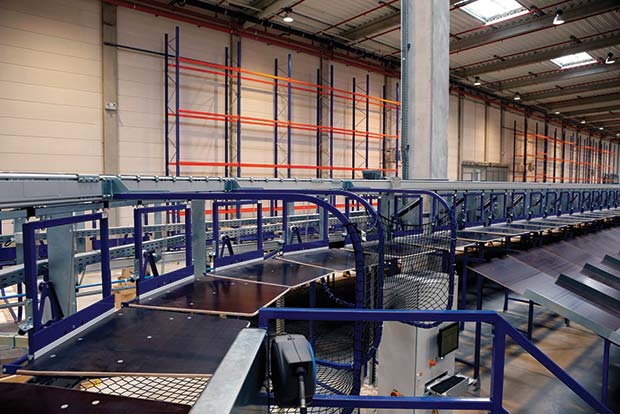Viewpoint:By Gordon Smith

The fashion retail sector is big business and it is undergoing radical change in just about every developed, international market.
According to the UK’s Office of National Statistics weekly sales of textiles, clothing and footwear averaged £1.2bn in 2013, with internet sales in December experiencing year on year growth of 9.1%, and the proportion of total sales made online in 2013 reaching 10.9%.
This shift to multi-channel shopping has placed a heavy emphasis on the fulfilment function.
In a ‘fast fashion’ market where new collections are presented every two months, keeping ahead of the competition and maximising margins demands an agile supply chain capable of delivering rapid store replenishment and ‘latest possible’ despatch for online orders.
However, remaining competitive in an Omni-channel world is becoming increasingly difficult using traditional, manual processes. Sales are won or lost on availability of stock at the point of sale, whether that be on-the-shelf or online, and those processes used in the past simply no longer offer the scale, speed and accuracy for assembling orders for such complex and diverse tasks. Greater use of automation is the only feasible and cost-effective way of competing in such a price sensitive, fast-fulfilment market.
Across our global businesses we are seeing strong demand for systems that are able to handle unit picking – single-order to multiple-order picking – and that are capable of stretching the online cut-off for overnight deliveries to 23:00 and beyond. These systems enable retailers to access and sort product at great speed, helping them to streamline and synchronise the flow of product to packing tables, and allowing orders to be prepared much faster. As many consumers shop online late into the evening, stretching the cut-off to the latest possible time gives those with the technology a significant competitive edge.
One technology that is taking off is a new pouch based sortation system using goods-on-hanger technology. By using a pouch to hold a hanging or flat product, items can be buffered in ‘carrousels in the air’ with product being pulled off automatically, and very quickly, when required. SDI’s MonaLisa enables the retailer to pick a wave of product and then pull that product very quickly to a packing station when required. This overcomes the difficulty of lots of ‘ones and twos’ or late order calls where pickers are under pressure to find items that may be at the furthest point in the distribution centre.
Using this technology can take an hour or two off the time taken to get picked items to the packing stations, but in addition, the innovation is very cost effective, as hanging garment technology costs a lot less than shuttles, buffer stock, conventional pallet conveyors and box conveyors. Successful applications in Germany are proving their worth.
In many instances, retail organisations are seeing the logic of bringing their store replenishment and fast-expanding internet fulfilment operations under one roof. As well as the intelligent use of a shared inventory to boost availability across multiple-channels, the increased scale plays towards wider use of warehouse automation, and in particular, fast sortation technology.
Retailers are using a combination of ‘goods on hangers’ systems, carton sorters, tilt-tray sorters and bomb-bay sorters to deliver operational improvements that push the boundaries of customer service to new heights. Instead of outdated methods of replenishing high street stores with full cartons, retailers can now replenish in single pieces, in line with demand experienced at individual stores. Tailoring replenishment to individual store needs makes the retail operation far slicker and allows for a more efficient allocation of stock, greater visibility of product in store and higher stock availability.
At one of our UK based retail customers a combination of automated technology facilitates over 1.4 million picks per week and at another retailer on the continent, two FSU shoe sorters mounted above one another give a combined capacity to sort 56,000 units per hour.
Overall, it is of critical importance to ensure a system is designed for meeting peak demand. But it is the inherent flexibility of a well designed sortation system that brings extra results. In addition to preparing orders for despatch, many of our customers use the sorters for say, sorting container loads of inbound goods or handling returns. In many ways, the sophistication of the software controlling the systems lends itself to flexibility and innovation.
Interestingly, warehouse control systems (WCS), which traditionally have been dedicated to material flow, are starting to be applied to more complex and sophisticated solutions geared towards merchandise management. This is due to the fact that retailers are picking a buffer stock and the materials handling equipment is having to hold that buffer stock and decide how best to cut it up for the most efficient and cost effective way of preparing multi-channel orders. This is far more demanding than traditional retail store replenishment operations. So today, there is a much greater emphasis on the sophistication of the software used in warehouse control systems – that is why a little time ago, we acquired a specialist software company in Germany.
Fashion retail has a major challenge ahead. Using automated sortation technology to full advantage presents a tremendous opportunity for those who chose to invest.
Gordon Smith is CEO of SDI Group, the global integrator of automated material handling systems.




Comments are closed.